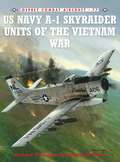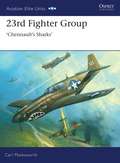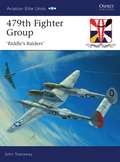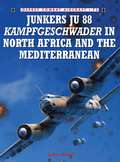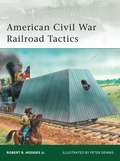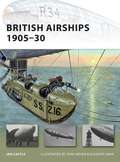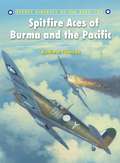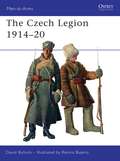- Table View
- List View
Saracen Strongholds AD 630–1050: The Middle East and Central Asia (Fortress)
by David Nicolle Adam HookThe Islamic world drew upon a myriad of pre-existing styles of fortification, taking Romano-Byzantine, Indian and Chinese ideas to create a highly effective and sophisticated hybrid fortification that was both new and distinctive. This book examines early Saracen fortifications, covering their historical background, socio-political circumstances, and their role in protecting industry, trade and the frontiers of the Islamic world. From the mayyad 'castles in the desert' of Jordan and Syria to the 'Round City of Baghdad' and the great gates of Cairo, this book provides an insight into the majesty of the Saracen forts, illustrated with specially commissioned artwork and cutaways, together with photographs of period engravings and images of the sites today.
US Cruisers 1883–1904: The birth of the steel navy (New Vanguard)
by John White Ian Palmer Lawrence BurrBy the end of the Civil War the US Navy was the most advanced in the world, but in subsequent years America's naval might dwindled. However, in the 1880s a 'New Navy' was born and at the forefront of its fleet were the mighty cruisers. Naval historian Lawrence Burr details how these cruisers allowed America to rebuild their navy, exploring the design and development of these ships. Placing these advances in context, through vivid accounts of how US cruisers performed in the Spanish-American War of 1898, notably at Manila Bay and Santiago, he investigates the emergence of the US Navy as a major power. Illustrated with early photographs and full-colour artwork, this is a concise history of the birth and development of a modern navy that was the precursor to the development of modern steel fleets around the world.
British Submarines of World War I (New Vanguard #145)
by Tony Bryan Innes McCartneyAs the major powers engaged in an arms race in the early years of the 20th century, the Admiralty was tasked with developing that deadly stalker of the high seas the submarine. In 1905, briefed with creating a vessel that could be employed on an enemy's coastline, the Admiralty took several technological leaps forward to match Germany's own revolutionary vessels. Written by an influential expert in the field and covering all classes of submarine developed and deployed during the war, this book includes great technical detail, gripping operational accounts and is accompanied by artwork. With fascinating details of daring submarine raids in the Baltic and the Dardanelles, this book reveals the exceedingly dangerous world of early submarine warfare which claimed an extraordinary number of lives on both sides and paved the way for a new kind of naval warfare in the 20th century and beyond.
US Helicopter Pilot in Vietnam (Warrior)
by Steve Noon Gordon L. RottmanThe helicopter changed war forever. This book examines the range of duties helicopter pilots carried out in Vietnam, from air-lift, med-evac and fire-support to landing in high volume crossfires in 'Hot LZs'. Protected by little more than an armoured seat, operating in terrible conditions and flying long hours these brave men led hard, dangerous lives, and casualties were high. Following these pilots from initial deployment through to the deadly thrill of combat in a war zone, Vietnam veteran Gordon L Rottman's book is a crucial examination of the pilots who fought so valiantly for their country. Often unmoved by the politics of the war, conflicts at home and other social issues, the Vietnam helicopter pilots just wanted to fly. As the saying went 'who needs drugs, I'm already high'.
Ki-43 ‘Oscar’ Aces of World War 2 (Aircraft of the Aces)
by Jim Laurier Hiroshi IchimuraDubbed the 'Oscar' by the Allies, the Ki-43 Hayabusa Peregrine was the most prolific Japanese fighter of World War 2. Designed for manoeuverability and speed, the low-wing model meant that firepower and safety had to be sacrificed, with only two machine guns per plane. Despite this, more Japanese pilots achieved Ace status flying the Hayabusa than any other plane. This book expertly charts the experiences of the pilots and discusses the early stages of the war in South-East Asia, China, Burma and New Guinea. Accompanied by detailed appendices and specially commissioned artwork, this is the first volume in English to focus exclusively on the exploits of the Ki-43.
P-36 Hawk Aces of World War 2 (Aircraft of the Aces #86)
by Chris Davey Kari Stenman Andrew Thomas Lionel PersynThe Curtiss P-36 was considered a revolution in performance design in comparison to other US fighters. Yet by the time of the Japanese attack on Pearl Harbor the P-40 was increasingly supplanting the P-36, which the US then exported to France under the guise of the Hawk 75. Flown by the French, captured by the Germans, sold to the Finns, transferred to India and Africa, and even incorporated into the RAF, the Hawk 75 saw service in every theatre of operations and in a variety of combat environments. This book depicts the fascinating life of a plane that fought on both sides in the war, with colour artwork, photographs and first-hand accounts.
Russian Battleship vs Japanese Battleship: Yellow Sea 1904–05 (Duel)
by Howard Gerrard Tony Bryan Robert Forczyk Ian PalmerThe first major clash between a European and Asian state in the modern era signalled the beginning of Japan's rise as a major power on the world stage. Watched by the rest of the world's superpowers, this incredibly violent war was disastrous for the Russians who, despite their superior numbers, were defeated by the Japanese underdogs in a spectacular fashion.The key technical elements of firepower, protection, maneuverability and communications for each side are covered in detail and accompanied by first-hand accounts and specially commissioned artwork to explain and illustrate this historically significant duel.
North Vietnamese Army Soldier 1958–75 (Warrior)
by Gordon L. Rottman Brian DelfCommonly mistaken for the locally raised Viet Cong, the NVA was an entirely different force, conducting large-scale operations in a conventional war. Despite limited armour, artillery and air support, the NVA were an extremely politicized and professional force with strict control measures and leadership concepts. Gordon Rottman follows the fascinating life of the highly motivated infantryman from conscription and induction through training to real combat experiences. Covering the evolution of the forces from 1958 onwards, this book takes an in-depth look at the civilian and military lives of the soldiers, whilst accompanying artwork details the uniforms, weapons and equipment used by the NVA in their clash against America and her allies.
US Navy A-1 Skyraider Units of the Vietnam War (Combat Aircraft)
by Jim Laurier Rick Burgess Zip RausaNicknamed the 'flying dump truck', the A-1 was a key component in naval air wings from the end of World War II into the 1960s, allowing the aircraft to play its part in the escalating conflict in Vietnam. Both A-1 attack and EA-1F airborne early warning aircraft saw action in Southeast Asia from 1960 through 1969, when the last examples were finally retired from carrier decks. The A-1s in particular bombed targets in both North and South Vietnam, despite the aircraft being highly vulnerable to enemy flak and fighters. Co-written by a two-tour Vietnam War combat veteran in the A-1, this is the first book that focuses exclusively on the aircraft's service in Vietnam.
Scottish Baronial Castles 1250–1450 (Fortress)
by Michael Brown Adam HookDevastated by the civil wars of the 17th century or by the neglect of their owners, the majority of Scottish baronial castles built between 1250 and 1450 survive as little more than skeletal ruins. These reminders of Scotland's past have captured the imaginations of romantics, artists, writers and tourists since the late 18th century. Often set in spectacular surroundings, on cliff-tops, islands, and gorges, their ruined grandeur evokes a medieval world of sieges, banquets and murders, and provides a rare physical link with the Anglo-Scottish wars of Robert the Bruce and William Wallace.
M551 Sheridan: US Airmobile Tanks 1941–2001 (New Vanguard)
by Steven J. Zaloga Tony BryanSince the advent of airmobile warfare, there have been numerous attempts to support paratroopers with attached armored vehicles. This book tells the story of the US experience with air-mobile tanks, starting with their efforts in World War II. However, full success was not achieved until the production of the M551 Sheridan. The history of this tank provides the focal point of this book, highlighting the difficulties of combining heavy firepower in a chassis light enough for airborne delivery. The book examines its controversial debut in Vietnam, and its subsequent combat history in Panama and Operation Desert Storm. It rounds out the story by examining the failed attempts to replace the Sheridan with other armored vehicles.
World War II Axis Booby Traps and Sabotage Tactics (Elite)
by Peter Dennis Gordon L. RottmanBooby traps laid by troops in war zones in World War II are largely neglected in histories and memoirs, and rarely examined in detail. Yet for a soldier, the threat of booby traps had to be at the forefront of his mind, and an ability to find and disarm them was essential. This is the first comprehensive study of World War II's battlefield booby traps, using information from rare wartime intelligence publications to identify, illustrate and describe the tactics of both Allied and Axis saboteurs. Examining all aspects of this secretive subject, from the equipment used to the techniques of placing and finding them, this book uncovers the daily risks faced by soldiers on the ground through the course of the war.
British Battleships 1939–45: Queen Elizabeth and Royal Sovereign Classes (New Vanguard)
by Tony Bryan Paul Wright Angus KonstamWith the outbreak of World War II, Britain's Royal Navy and her fleet of battleships would be at the forefront of her defence. Yet ten of the 12 battleships were already over 20 years old, having served in World War I, and required extensive modifications to allow them to perform a vital service throughout the six long years of conflict. This title offers a comprehensive review of the development of these British battleships from their initial commissioning to their peacetime modifications and wartime service, with detailed descriptions of the effectiveness of the main armament of individual ships. With specially commissioned artwork and a dramatic re-telling of key battleship conflicts, this book will highlight what it was like on board for the sailors who risked their lives on the high seas.
Kriegsmarine Auxiliary Cruisers (New Vanguard)
by Ian Palmer Gordon WilliamsonDespite being relatively unknown compared to famous ships like Graf Spee or Bismarke, or the more famous U-boats, the Auxiliary Cruisers were immensely successful, not only in the number of enemy ships they sank, but in the resources which were tied up trying to track them down. The Royal Navy's auxiliary cruisers tended to be merchant vessels used to protect convoys from attack. The German Auxiliary Cruisers, however, heavily armed and usually carried torpedo tubes as well as guns and even sometimes their own aircraft. These ships were aggressive predators, searching the sea lanes for unsuspecting enemy merchants, and were not only capable of destroying enemy merchant ships, but also of defending themselves against well-armed enemy warships. This book looks at the specifications and designs of the 11 Auxiliary Cruisers, as well as their combat histories, their eventual fates, and the careers of some of the most famous commanders.
23rd Fighter Group: Chennault’s Sharks (Aviation Elite Units)
by Jim Laurier Carl MolesworthFamous for the fearsome sharksmouths that adorned their planes, the 23rd FG fought a guerrilla war against the Japanese, steadily moving pilots and aircraft from one remote air base in China to another to keep the enemy off balance. Because China could only be supplied by air from India, there were constant shortages of aircraft, fuel and ammunition with which to contend. The 23rd FG met these challenges head-on, and by the end of the war its pilots had compiled a score of 594 aerial victories and nearly 400 ground kills. The human cost was high, however – 126 pilots lost their lives in China while serving in the 23rd.
479th Fighter Group: ‘Riddle’s Raiders’ (Aviation Elite Units)
by John Stanaway Chris DaveyFormed in October 1943, the 479th FG claimed an impressive history against the Luftwaffe during the final year of the war. Originally flying P-38s, the 479th's pilots had a fierce pride of arms. They earned a Presidential Distinguished Unit Citation in the late summer of 1944 and were also credited with the USAAF's first German jet kill in July 1944. Eventually transitioning to the P-51D in September 1944, the 479th excelled with the Mustang. The 479th FG was credited with scoring the last aerial victory claimed by the Eighth Air Force's VIII Fighter Command, on 25 April 1945. By VE-Day, 29 pilots flying in the group had earned "ace†? status.
Petersburg 1864–65: The longest siege (Campaign #208)
by Peter Dennis Ron FieldIn 1864 General Ulysses S. Grant decided to strangle the life out of the Confederate Army of Northern Virginia by surrounding the city of Petersburg and cutting off General Robert E. Lee's supply lines. The ensuing siege would carry on for nearly ten months, involve 160,000 soldiers, and see a number of pitched battles including the Battle of the Crater, Reams Station, Hatcher's Run, and White Oak Road. After nearly ten months, Grant launched an attack that sent the Confederate army scrambling back to Appomattox Court House where it would soon surrender. Written by an expert on the American Civil War, this book examines the last clash between the armies of U.S. Grant and Robert E. Lee.
Junkers Ju 88 Kampfgeschwader in North Africa and the Mediterranean (Combat Aircraft)
by John WealThis volume follows the Luftwaffe's twin-engined 'Wunderbomber' southwards to describe its deployment in North Africa and the Mediterranean theatre of war. Early 1941 saw the first sporadic air raids on Malta, followed by the campaign in the Balkans which resulted in the conquests of Yugoslavia, Greece and Crete. After supporting land operations in North Africa during the latter half of 1941, the Ju 88s resumed their assault on Malta. Bringing the story to life are personal accounts of the more famous actions – the bombing of shipping off the coast of Greece and the sinking of three Royal Navy destroyers south of Crete, all illustrated with rare photographs and full-colour profiles.
American Civil War Railroad Tactics (Elite)
by Peter Dennis Robert R. Hodges Jr.The American Civil War was the world's first full-blown 'railroad war'. The well-developed network in the North was of great importance in serving the Union armies' logistic needs over long distances, and the sparser resources of the South were proportionately even more important. Both sides invested great efforts in raiding and wrecking enemy railroads and defending and repairing their own, and battles often revolved around strategic rail junctions. Robert Hodges reveals the thrilling chases and pitched battles that made the railroad so dangerous and resulted in a surprisingly high casualty rate. He describes the equipment and tactics used by both sides and the vital supporting elements – maintenance works, telegraph lines, fuel and water supplies, as well as garrisoned blockhouses to protect key points. Full-colour illustrations bring the fast-paced action to life in this fascinating read; a must-have volume for rail and Civil War enthusiasts.
The Belgian Army in World War I (Men-at-Arms)
by Patrice Courcelle Ronald Pawly Pierre LierneuxWhile small in numbers, the Belgian Army played a vital role in World War 1 that is often overlooked. Germany's invasion of neutral Belgium, which led Britain to declare war in August 1914, should have been swift and fierce yet the unexpected heroic defence, against great odds, of Belgian fortresses, frustrated the German Schlieffen Plan for a thrust to Paris and a lightning victory. The plucky Belgian resistance proved successful in buying time for French and British troops to mobilize and report to the front, where the Belgians would then go on to fight, stubbornly defending the northern end of the Allied trench line for the rest of the war. Discover the story of this determined Army, from their organization and commanders, to their uniforms and equipment. The only main combatant army of World War I not previously covered by Osprey, this volume will be an important addition to any enthusiast's collection, accompanied by detailed artwork and archive photographs.
US Armed Forces in China 1856–1941 (Men-at-Arms)
by Mike Chappell John LangellierThis volume reveals the little-known story of the 90-year presence of American forces in China until the fall of Peking in 1941. Included is coverage of the first operations on the Pearl River in 1856 as well as US involvement in the Boxer Rebellion of 1900. As China entered a chaotic period in her history, known as the years of the "Warlords†?, American marines also participated in numerous small-scale amphibious landings. Finally, during the later Sino-Japanese War and early into World War II, US volunteers of the "Flying Tigers†? became renowned for their combat missions in support of Chinese Nationalist forces, and their aerial duels are also recounted by the author John P. Langellier, who has spent several years researching the subject in the US and China. Discover the history of these various actions and the different services involved, recreated in color artwork and illustrated with rare, previously unpublished photographs.
British Airships 1905–30 (New Vanguard)
by Tony Bryan Ian CastleThis book reveals the fascinating story of the cat and mouse duel between the airship and another pioneering form of technology – the submarine during World War 1. Detailed cut-away drawings reveal the design and development of the airship, during and after the war, whilst full-colour illustrations depict the airship in dramatic action shots. A tragic accident in 1930 brought the airship's military service to an end, resulting in a tiny window in which they were used and little acknowledgement over the years. Ian Castle gives deserved attention to an aeronautical wonder that for a short amount of time played a crucial service to the defence of Britain.
Spitfire Aces of Burma and the Pacific (Aircraft of the Aces #87)
by Chris Davey Andrew ThomasThe arrival of the Spitfire in Burma came at a crucial time as the RAF struggled against the Japanese to support the Chindit operation on the ground. Proving a huge boost to morale, the Spitfire played a large part in defeating the enemy, and covering the subsequent Allied advance through Burma, protecting the ground troops and providing vital supplies. Covering this little documented aerial war, this book tells the stories of the 54 aces who flew against the Japanese, and also those who fought in India and Australia. Full-colour artwork reveals the markings and paint schemes of this most-famous of British planes, whilst first-hand accounts and archive photographs bring the aerial battles of Burma, India and Australia to life.
Operation Dragoon 1944: France’s other D-Day (Campaign)
by Steven J. Zaloga John WhiteOperation Dragoon, the Allied landings in southern France on August 15, 1944, was one of the most controversial operations of 1944, leading to a deep divide between United States and British planners. The US objective was to threaten the rear of the German armies occupying France by a landing on the eastern French coast and to push rapidly northward towards Lorraine to meet up with Allied forces bursting out of Normandy. Popular Osprey author Steve Zaloga tells the story of this ultimately successful operation, from the derisive debates between the Allied commanders to the men who hit the beaches and charged ashore to help liberate occupied France.
The Czech Legion 1914–20 (Men-at-Arms)
by Ramiro Bujeiro David BullockThe Czech Legion was not just a single military unit, but a volunteer army that fielded up to 100,000 troops on the Allied side on all three main fronts of the war. Since only the defeat of Austro-Hungary and Germany offered any hope for Czech national independence, they were amongst the most motivated and steadfast of the Allied forces. After the Bolshevik Revolution, they fought their way across Russia, captured the Russian national gold reserves and used this as a bargaining chip to force the Bolsheviks to allow them to return home. Today the Legion is recognised as the founding fathers of Czech nationhood. This very colourful force of World War I has never before been detailed in English and is illustrated with an astonishing array of never-before-published photographs.








